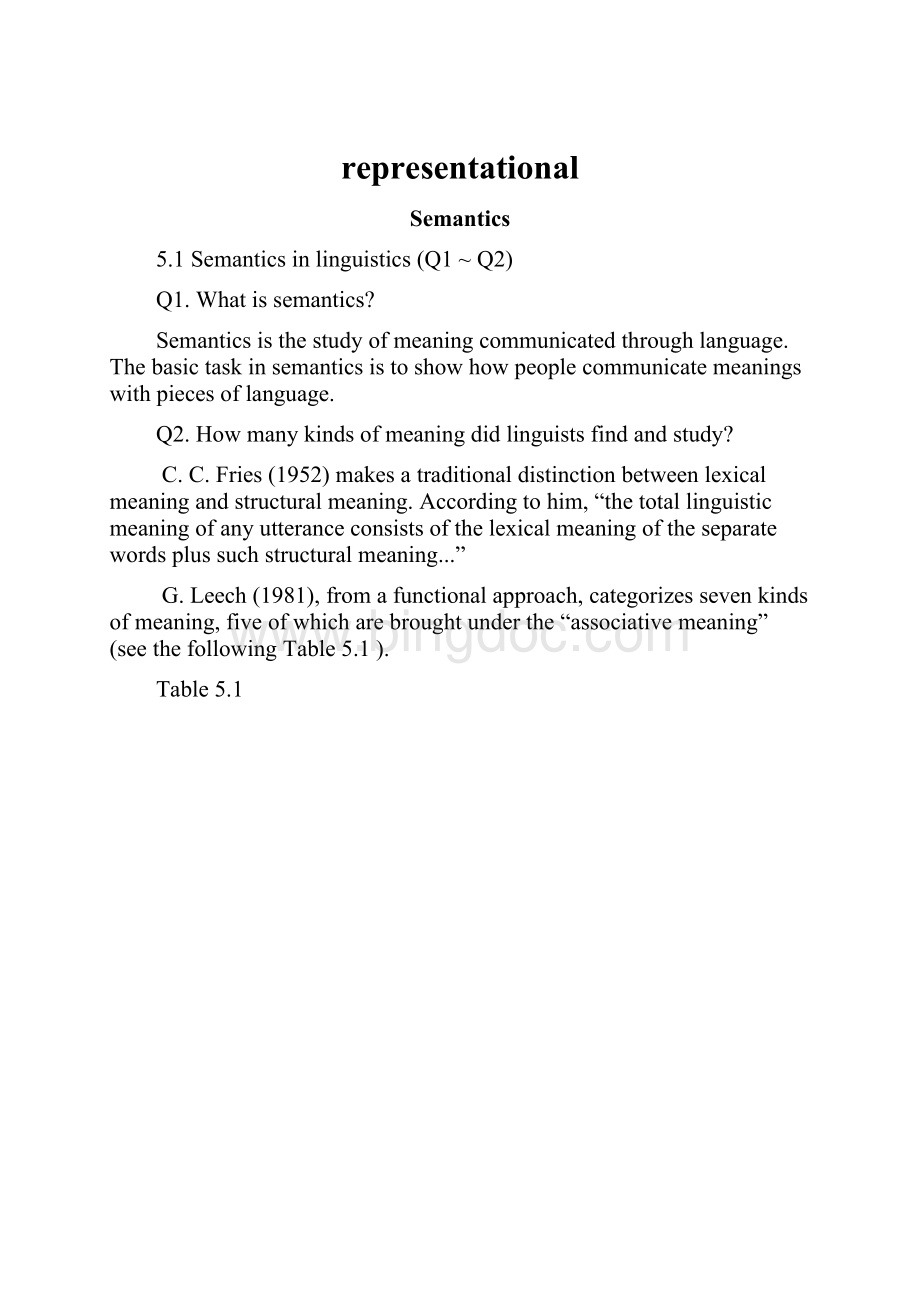representational.docx
《representational.docx》由会员分享,可在线阅读,更多相关《representational.docx(22页珍藏版)》请在冰点文库上搜索。

representational
Semantics
5.1Semanticsinlinguistics(Q1~Q2)
Q1.Whatissemantics?
Semanticsisthestudyofmeaningcommunicatedthroughlanguage.Thebasictaskinsemanticsistoshowhowpeoplecommunicatemeaningswithpiecesoflanguage.
Q2.Howmanykindsofmeaningdidlinguistsfindandstudy?
C.C.Fries(1952)makesatraditionaldistinctionbetweenlexicalmeaningandstructuralmeaning.Accordingtohim,“thetotallinguisticmeaningofanyutteranceconsistsofthelexicalmeaningoftheseparatewordsplussuchstructuralmeaning...”
G.Leech(1981),fromafunctionalapproach,categorizessevenkindsofmeaning,fiveofwhicharebroughtunderthe“associativemeaning”(seethefollowingTable5.1).
Table5.1
Conceptualmeaning
Logical,cognitive,ordenotative
Associativemeaning
Connotativemeaning
Socialmeaning
Affectivemeaning
Reflectedmeaning
Collocativemeaning
Whatiscommunicatedbyvirtueofwhatlanguagerefersto.
Whatiscommunicatedofthesocialcircumstancesoflanguageuse.
Whatiscommunicatedofthefeelingsandattitudesofthespeaker/writer
Whatiscommunicatedthroughassociationwithanothersenseofthesameexpression.
Whatiscommunicatedthroughassociationwithwordswhichtendtooccurintheenvironmentofanotherword.
Thematicmeaning
Whatiscommunicatedbythewayinwhichthemessageisorganizedintermsoforderandemphasis.
Differentfromthetraditionalandthefunctionalapproach,F.R.Palmer(1981)andJ.Lyons(1977)proposeapragmaticapproachwhichdrawsadistinctionbetweensentencemeaningandutterancemeaning.Theformerisdirectlypredictablefromthegrammaticalandlexicalfeaturesofthesentence,whilethelatterincludesallthevarioustypesofmeaningnotnecessarilyassociatedthereto.
5.2SemanticUnits(Q3)
Q3.Whatarethesemanticunits?
Whatarethenamingunitsandcommunicationunits?
Semantictraitsaremorpheme,word,phraseandidiom,sentenceandtext.Thebasicnamingunitinlanguageisnotionalwordandphrasemadeupofnotionalwords.Communicationunitistheunitwithwhichpeopleexpresstheirthoughts,feelingsandintentions.Sentenceisthebasicunitofthiskind.
5.3Meaningoftheword(Q4~Q7)
Q4.Howmanyviewsaretheretowardsthemeaningoftheword?
Whatarethey?
Therearethree.Referentialtheoryordenotationaltheoryisatheorywhichrelatesthemeaningofawordtothethingitrefersto,orstandsfor.
Mentalisttheoriesofmeaning(representationalapproach)holdthatthemeaningofeachwordistheideaassociatedwiththatwordinthemindsofspeakers.Therearethreeviewsinthisline:
(1)meaningasimages,
(2)meaningasconcepts,and(3)meaningassense.
Theusetheoryofmeaningadvocatesthatthemeaningofawordisdeterminedbyitsuseinthelanguagecommunity,andtospecifythatuseistospecifyitsmeaning.Q5.Whatissenseandwhatisreference?
Howaretheyrelated?
Sensereferstotheinherentmeaningofalinguisticform,whichisacollectionofsemanticmeanings,abstractanddecontextualized,whilereferenceiswhatalinguisticformreferstointherealworld.Itisamatteroftherelationshipbetweentheformandthereality.
Q6.Whatisthesemantictriangle?
Itisatheory,manifestedinthefollowingdiagram,proposedbyOgdenandRichardswhichexplicitlyemploysthenotionof“concept”tointerpretthemeaningofaword---therelationbetweenawordandathingitreferstoisthroughthemediationofconcept.
Concept
WordThing
Q7.Whatisthedifferencebetweenmeaning,concept,connotation,anddenotation?
Meaningreferstotheassociationoflanguagesymbolswiththerealworld.Therearemanytypesofmeaningsaccordingtodifferentapproaches.Conceptistheimpressionofobjectsinpeople’smind;connotationistheimpliedmeaning,similartoimplicationandimplicature;denotation,likesense,isnotdirectlyrelatedwithobjects,butmakestheabstractassumptionoftherealword.
5.4Meaningofthesentence(Q8~Q11)
Q8.Whatistherelationshipbetweensentencemeaningandwordmeaning?
Giveexamples.
Themeaningofsentenceissupposedtobethecombinationofwordmeaningandsentencestructure.SentencesusingthesamewordsmaymeanquitedifferentlyinthatthewordsarearrangedindifferentOrders.Forexample,
(a)Themanchasedthedog.
(b)Thedogchasedtheman.
Evenwhentwosentencesmeansimilarlyas(c)and(d),thereisstilldifferenceinthematicmeaning:
(c)I’vealreadyseenthatfilm.
(d)ThatfilmI’vealreadyseen.
Withsentenceslike(e),weneednotonlyknowthelinearorderofasentence,butalsothehierarchicalstructure:
(e)ThesonofPharaoh’sdaughteristhedaughterofPharaoh’sson.
Thehierarchicalstructuremaybeanalyzedasthefollowing:
ThesonofPharaoh’sdaughteristhedaughterofPharaoh’sson
Sentencesalsoexhibitmeaningpropertiesandrelationsthatwordsandphrasesmaylack.Communicativepotentialisonepointinease.Adiagramforthismaybeasfollows:
(f)Declarativesentence:
Usedtoconstate(assert,state,claim,etc.)
(g)Imperative:
Usedtodirect(order,request,command,etc.
(h)Interrogative:
Usedtoquestion.
Q9.Areutterances,sentences,andpropositionsthesame?
No.Thesethreetermsareusedtodescribedifferentlevelsoflanguage.Themostconcreteisutterancewhichiscreatedbyspeaking(orwriting)apieceoflanguage.Sentences,ontheotherhand,areabstractgrammaticalelementsobtainedfromutterances.Forexample,anutterancehasatone,orperhapssomeaccentduetoregionalorsocialvariationandphoneticdetailswhichidentifyindividualspeakers,etc.Butatthelevelofsentence,thesekindsofinformationareignored.Propositionsaretheresultofafurtherabstractionofsentences,whicharedescriptionsofstatesofaffairsandwhichsomewritersseeasabasicelementofsentencemeaning.Forexample,thetwosentences“CaesarinvadedGaul”and“GaulwasinvadedbyCaesar”holdthesameproposition.
Q10.Whatisthetruthvalueofproposition,andwhatisthetruthcondition?
Truthvalueistheveryimportantpropertyofproposition.Itdescribeswhetherapropositionistrueorfalse.Thetruthconditionisthefactsthatwouldhavetoobtaininrealitytomakeapropositiontrueorfalse.
Q11.Howarethetruthvaluesofthesentences“Eitheritisraininghereoritisn’traininghere”and“Someboysthataresickarenotboys”differentfromthoseofthesentences"Theearthisround”and“PRCwasfoundedin1950”?
Theformersentencesarerespectivelylinguisticallytrue(alsocalledanalyticallytrue)andlinguisticallyfalse(contradictory).Thelattertwosentencesarerespectivelyempiricallytrueandempiricallyfalse.
Thetruthconditionofasentencewhichislinguisticallytrueisdeterminedsolelybythesemanticsofthelanguageanditisnotnecessarytocheckifanyfactsaboutthenonlinguisticworldinordertodeterminetheirtruthorfalsehood.Whiletheknowledgeofthelanguagealonedoesnotdeterminethetruthconditionofanempiricallytruesentence,anditisnecessarytochecktheworldinordertoverifyorfalsifyit.
5.5Meaningsofphrasesandidioms(Q12~Q13)
Q12.Howisaphrasedifferentfromanidiomandaproverb?
Phraseisnotasentence.Itisthenamingunitinsteadofcommunicationunit,anditsmeaningistheresultofthecombinationofthemeaningsofitsindividualwordsandthemeaningofitsstructure.Whileanidiomisthefossilizedphrasewhosemeaning,generallyspeaking,cannotbeinferreddirectlyfromthemeaningsofitscomponentwords.Proverbsarefossilizedsentences.
Q13.Whatiscollocation?
Collocationisatermusedinlexicologybysomelinguiststorefertothehabitualco-occurrencesofindividuallexicalitems.Forexample,wecan“correct”a“mistake”,“read”a“book”,and“watchTV”.Noonecan“correct”atelevisionor“read”amistake.
Wecanfindoutthemeaningofawordbythecompanyitkeeps,accordingtoH.Firth,anEnglishsemanticist.
5.6Semanticrelations(Q14~Q31)
Q14.Whatisasemanticfield?
Canyouillustrateit?
Itisanorganizationalprinciplethatthelexiconandgroupsofwordsinthelexiconcanbesemanticallyrelated,ratherthanalistingofwordsasinapublisheddictionary.Onaverygeneralandintuitivelevel,wecansaythatthewordsinasemanticfield,thoughnotsynonymous,areallusedtotalkaboutthesamegeneralphenomenon,andthereisameaninginclusionrelationbetweentheitemsinthefieldandthefieldcategoryitself.Classicalexamplesofsemanticfieldsincludecolorterms
(red,green,blue,yellow),kinshipterms(mother,father,sister,brother),andcookingterms(boil,fry,broil,steam)assemanticfields.
Q15.Illustratehowthesemanticfielddiffersfromoneculturetoanother?
Let’stakekinshiptermsforexample.Everylanguagehasitskinterms,buttheyareusedindifferentways.Forinstance,thekintermsforthepeopleofthesameparentsinEnglisharebrotherandsister;whileinChinese哥哥(elderbrother),弟弟(youngerbrother),姐姐(eldersister),妹妹(youngersister).Englishmakesonlyonedistinction--sex;however,inadditiontosex,Chinesegivesanother---beingyoungerorolder.
Q16.WhatarethemajortypesofsynonymsinEnglish?
Theyaredialectalsynonyms,stylisticsynonyms,emotivesynonyms,collocationalsynonyms,andsemanticsynonyms.Examplesareasfollows:
fondof,keenon(collocational)
autumn,fall(dialectal)
dad,father(stylistic)
thrifty,miserly,economical(emotional)
escape,flee(semantic)
17.Inwhatwaydothefollowingpairsoffercontrast?
(a)earth/ə:
ө/n.1.ourplanet.2.thesoilonthesurfaceofourplanet.
Bankl/b